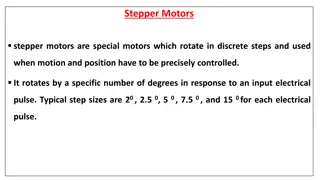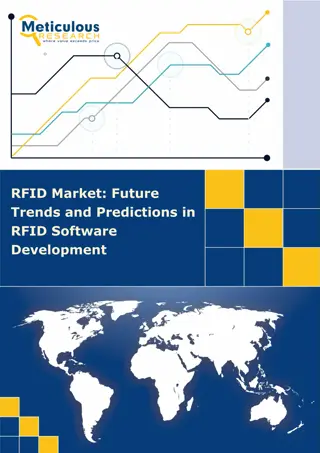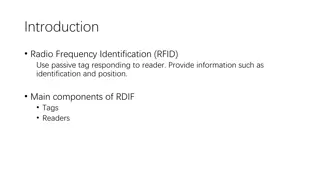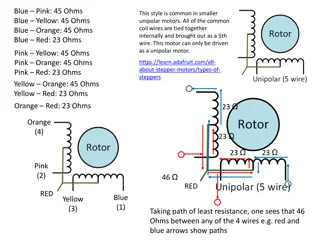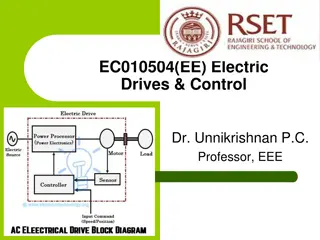Implementing RFID Tags in Preventive Maintenance for Motors and Generators
Condition monitoring data can be leveraged to establish preventive maintenance programs for electrical rotating units like motors and generators. Integrating RFID sensor tags allows for a condition-based monitoring program, enhancing equipment performance analysis. Learn about the benefits of preventive maintenance programs, the essential components required for operational systems, and the significance of temperature and vibration readings in maintaining electric rotating machinery.
- Preventive Maintenance
- RFID Technology
- Condition Monitoring
- Motors and Generators
- Equipment Performance
Download Presentation

Please find below an Image/Link to download the presentation.
The content on the website is provided AS IS for your information and personal use only. It may not be sold, licensed, or shared on other websites without obtaining consent from the author. Download presentation by click this link. If you encounter any issues during the download, it is possible that the publisher has removed the file from their server.
E N D
Presentation Transcript
RFID Tags Used in Preventive Maintenance Programme for Motors and Generators Tracy Aleong1, Kit Fai Pun2 Department of Mechanical & Manufacturing Engineering, Faculty of Engineering, The University of the West Indies, Trinidad and Tobago, West Indies IConETech-2020, Faculty of Engineering, The UWI, St. Augustine, Trinidad and Tobago
Agenda Introduction Preventative Maintenance Motors & Generators Condition Monitoring Temperature and Vibration About RFID Technology and Applications RFID System Components Limitations Conclusion IConETech-2020, Faculty of Engineering, The UWI, St. Augustine, Trinidad and Tobago
Introduction Condition monitoring data can be used to develop a preventative maintenance programme for many electrical rotating units such as motors and generators. The benefits of such programmes justifies the case to implement a system capable of providing the sensor data used to analyse how the units in operations are performing at any given time. A look at integrating RFID sensor tag to create a condition- based/preventative maintenance based monitoring programme for electric rotating machine such as motors and generators. Cover the basic system components required to have an operational system capable of collecting temperature and vibration readings on both rotary and stationary parts of the machine. IConETech-2020, Faculty of Engineering, The UWI, St. Augustine, Trinidad and Tobago
Preventative Maintenance Preventive Maintenance Programme can help support the reliability and long-life operation of motors and generators. These programmes are involve using sensing techniques used in condition monitoring of live equipment status to trend the performance of equipment and create awareness of potential issues or failure. Many organisations lack such a programme. High start-up cost is a main factor deterring companies from implementing this type of program. Complexity is another factor. Machines with moving parts require some form of wireless technology in order to capture data from areas such as rotors. Using major sensing techniques for monitoring live equipment status requires special installation. IConETech-2020, Faculty of Engineering, The UWI, St. Augustine, Trinidad and Tobago
Condition Monitoring of Motors and Generators High Temperatures and Excessive Vibrations are known to be some of the reasons why electrical rotating equipment expectantly shutdown, regardless of specific type. When the rotating mass becomes unbalanced, the level of vibration and potentially the thermal signature changes in relation to the level of imbalance equipment. On the other hand, overheating is relatively common for a number of reasons, i.e. overload, poor power service factor, frequent stops and starts or environmental reasons. electric motor within the rotating condition, high effective Fig 1: A Cutaway view of a typical IConETech-2020, Faculty of Engineering, The UWI, St. Augustine, Trinidad and Tobago
Condition Based Monitoring Temperature Measurements Temperature detection is an effective global monitoring technique used for most electrical machines aiding in the prevention and occurrence of overheating. Excessive heat causes rapid deterioration of insulation windings in Induction and synchronous units . A combination of thermal, electrical and mechanical stresses coupled with environmental stresses causes the windings to age over time. Failure is not always immediate but can occur at any given time. In the case of machines using permanent magnets, high temperature can cause loss of magnetization. Magnets that have been demagnetised cannot regain its original magnetic strength even after conditions have normalised. The degree rule applies to motors operating at above rated temperature; insulation life drops by half for each 10 C of over temperature. IConETech-2020, Faculty of Engineering, The UWI, St. Augustine, Trinidad and Tobago
Condition Based Monitoring - Mechanical Vibration The vibration of any object in motion is characterised by variations of amplitude, intensity, and frequency. usually involves a non-invasive sensing method sometimes placed in regions of the machine where it can measure vibration of these parts: Bearings Gearbox Rotor parts Some undesirable conditions that can be identified are unbalance, misalignment, looseness, bearing wear, rubbing, hydraulic problems, electrical problems, resonance, and eccentricity of rotating parts. Vibration analysis looks for anomalies and change from the system s established vibration signature. The data is correlated to a physical phenomena and then used to assess the health of the equipment. It Fig 2: Vibration Parameters IConETech-2020, Faculty of Engineering, The UWI, St. Augustine, Trinidad and Tobago
Data Acquisition with RFID Sensor Tag System Some rotating equipment manufacturers use battery operated wireless sensors for measuring temperature and vibration directly on the rotor and shaft during the testing phase. Product performance and adherence to specifications are tested. This action occurs before shipping out of the factory, therefore installing those types of sensors are quick and easy to complete in comparison to wired sensors over the brushing. In this case, battery life rarely pose an issue to the operation, as the testing is short lived. For continuous operational testing as used in condition monitoring, wireless sensors are not the optimal choice with frequent battery changes and process interruptions to allow change out and higher operational cost. RFID systems can now fill some of the gaps left in using those other systems. The RFID tags would allow the connection of the physical assets to the digital world having a direct effect to a company s business drivers such as cost savings, greater operational efficiency and productivity. IConETech-2020, Faculty of Engineering, The UWI, St. Augustine, Trinidad and Tobago
About RFID Technology RFID is a form of wireless communication that incorporates the use of electromagnetic or electrostatic coupling in the radio frequency portion of the electromagnetic spectrum to uniquely identify an object, animal or person. Traditionally RFID tags are used for tracking purposes. Inventory Personnel & Access Assets Manufacturing Fig 3: RFID Tracking Applications IConETech-2020, Faculty of Engineering, The UWI, St. Augustine, Trinidad and Tobago
RFID Sensor Tag Applications Now RFID has been combined with Smart Sensor Technology capable of measuring physical variables. Fig 4: Applications of RFID sensors. IConETech-2020, Faculty of Engineering, The UWI, St. Augustine, Trinidad and Tobago
RFID Sensor Tag System Components The basic components for an RFID Sensor Tag System for monitoring temperature and vibrations : RFID Passive Sensor Tag or Transponder- With integrated Temperature and Vibration sensing capability. RFID Reader -Compatible handheld or fixed Reader with integral antenna Logging Station -Compatible PC/Laptop/Tablet & proprietary software (depending on supplier of Tag and reader) with access to IoT communication. Figure 5: Components of RFID Sensor Tag System IConETech-2020, Faculty of Engineering, The UWI, St. Augustine, Trinidad and Tobago
RFID System Components - Tag or Transponder A Passive RFID Tag in its most simplistic form comprises of 3 parts; 1. An antenna for transmitting receiving signals; 2. An RFID chip (or integrated circuit, IC), the brains of the device; 3. Encapsulation. Passive tags have no internal power (battery). They are widely used in comparison to those that have an internal battery. They are smaller, thinner, longer lasting and less expensive to implement. These tags rely on an external source to be powered up . This is achieved by the electromagnetic field (EMF) created by the RFID reader in reading range sending a transmission signal. The tag s antenna captures coupled energy from the EMF and transfers the tag s ID and stored information. The coupled energy is rectified and the voltage multiplied via a multistage Greinacher half-wave rectifier to power up the IC. The sensor tag versions operate in the same manner, as RF energy is harvested from the RF radiation emitted by the reader to power the circuit and complete the sensing. The inductive coupling or backscattered radio wave in RF identification is used to detect the physical parameters of tagged objects, hence the ability to work as a wireless sensor. IConETech-2020, Faculty of Engineering, The UWI, St. Augustine, Trinidad and Tobago
RFID System Components - RFID Reader & Logging Station The main functions of an RFID reader is to collect the data stored in the tag and provide power through the emission of radio waves. The reader emits radio waves in ranges of anywhere from one (1) inch to one hundred (100) feet or more, depending upon its power output and the radio frequency user. When an RFID tag passes through the electromagnetic zone or read range, it detects the reader s activation signal. The reader decodes the data encoded in the tag s IC and the data is passed to the host computer or logging station for storage or processing. The reader can be connected directly to the computer via USB or serial either for transferring information or through Bluetooth communication. If a reader is mounted close to the installed sensor tags, a portable host such as a tablet is easier to operate. The availability of internet connection opens the opportunity for remote access and sharing of information to key stakeholders and consultation with data analysing specialist. IConETech-2020, Faculty of Engineering, The UWI, St. Augustine, Trinidad and Tobago
RFID Reader & Logging Station For conditions, sensor tags can be installed on different parts of a rotating machine but the best locations should be considered. Having proper measurement coverage is important to achieving effective condition analysis. Figure 5 shows the distribution of temperature sensor tags on the rotor of motor. Mounting sensors on the frame and other accessible parts can be considered. The more sensor tags used, the more information can be collected to build a thermal vibration map of the rotor and other parts of the unit.. temperature and vibrations Fig 6: RFID Sensor Tags installed on rotor For vibration monitoring, the three main areas of importance to monitor; bearing gearbox and rotor for rotating machines IConETech-2020, Faculty of Engineering, The UWI, St. Augustine, Trinidad and Tobago
Limitations of Use As with most technological systems, there are limiting factors for use of RFID sensor tags in field application. The following applies to an industrial environment setting and must be considered in determining suitability: Design and installation Frequency Standardization of Frequencies Environmental Effects Security and privacy issues Social and legal issues Data Collision IConETech-2020, Faculty of Engineering, The UWI, St. Augustine, Trinidad and Tobago
Conclusion RFID Technology can fill some of the gaps left from those systems previously used in condition monitoring including other wireless technologies. The basic RFID Sensor tag and system components that can be used for condition based monitoring of Temperature and Vibration parameters of electrical rotating equipment was presented. The used of RFID sensor tag for this application was chosen as the technology is completely autonomous, inexpensive, and easy to install. This makes it a higher potential option for implementing it as part of a system dedicated to preventive maintenance of motors and generators especially those currently operating in the field without any form of performance analysis. Consideration must be given for the limitation of using this solution in the field. energy-independent, IConETech-2020, Faculty of Engineering, The UWI, St. Augustine, Trinidad and Tobago
Smart Technical Process Solutions Limited Provision of New and Replacement Tags of various material and sizes (Metal, Traffolyte, etc) using different labelling technology and techniques. Replace data tags on critical equipment on a routine basis. Conducts site survey to catalogue all installed equipment/ instrumentation and create data base of equipment to preserve specification that is normally lost with wear and tear. IConETech-2020, Faculty of Engineering, The UWI, St. Augustine, Trinidad and Tobago
REFERENCES Bilic, H Gokay, Tarik Buyukoztekin, and Serhan Ozdemir. 2018. "The Use of Chipless Sensors with RFID for Condition Monitoring." 2018 International Conference on Artificial Intelligence and Data Processing (IDAP). Choperena, Mikel. 2016. "RFID-based sensors as a data source for the IoT." Accessed 03 February. https://www.smart2zero.com/news/rfid-based-sensors-data-source- iot/page/0/1. Dynapar. 2020. "Vibration Analysis & Vibration Monitoring ". Accessed 25- Feb. https://www.dynapar.com/Technology/Vibration-Analysis. Engineering, Plant. 2020. "When it comes to motors, how hot is hot?". Accessed 02/25. https://www.plantengineering.com/articles/when-it-comes-to-motors-how-hot-is- hot/. E4U, Electricityforyou. 2020. "What is Frequency and How To Measure Frequency." https://www.electrical4u.net/electrical-basic/frequency-measure-frequency/. Finkenzeller, Klaus. 2003. "RFID handbook [electronic resource]: fundamentals and applications in." Hossain, MD Shamim Shahriar, and Nemai Karmakar. 2006. "An overview on RFID frequency regulations and antennas." 2006 International Conference on Electrical and Computer Engineering. Hou, Liqun, and Neil W Bergmann. 2012. "Novel industrial wireless sensor networks for machine condition monitoring and fault diagnosis." IEEE transactions on instrumentation and measurement 61 (10): 2787-2798. Kaur, Mandeep, Manjeet Sandhu, Neeraj Mohan, and Parvinder S Sandhu. 2011. "RFID technology principles, advantages, limitations & its applications." International Journal of Computer and Electrical Engineering 3 (1): 151. Korkua, Suratsavadee, Himanshu Jain, Wei-Jen Lee, and Chiman Kwan. 2010. "Wireless health monitoring system for vibration detection of induction motors." 2010 IEEE Industrial and Commercial Power Systems Technical Conference-Conference Record. Kuppusamy, Palanivel. 2019. "Smart Education Using Internet of Things Technology." In Emerging Technologies and Applications in Data Processing and Management, 385-412. IGI Global. Meng, Zhaozong, and Zhen Li. 2016. "RFID Tag as a Sensor-a review on the innovative designs and applications." Measurement science review 16 (6): 305-315 McKenzie, Ian. 2018. "What is the relationship between back EMF, flux, and the speed of a DC motor?". Accessed February. https://www.quora.com/What-is-the- relationship-between-back-EMF-flux-and-the-speed-of-a-DC-motor. Stone, GC. 2013. "Condition monitoring and diagnostics of motor and stator windings A review." IEEE Transactions on Dielectrics and Electrical Insulation 20 (6): 2073- 2080. Want, Roy. 2006. An Introduction to RFID Technology, IEEE Pervasive Computing. Jan. Weis, Stephen A. 2007. "RFID (radio frequency identification): Principles and applications." System 2 (3): 1-23. IConETech-2020, Faculty of Engineering, The UWI, St. Augustine, Trinidad and Tobago
THANK YOU! Questions? IConETech-2020, Faculty of Engineering, The UWI, St. Augustine, Trinidad and Tobago





